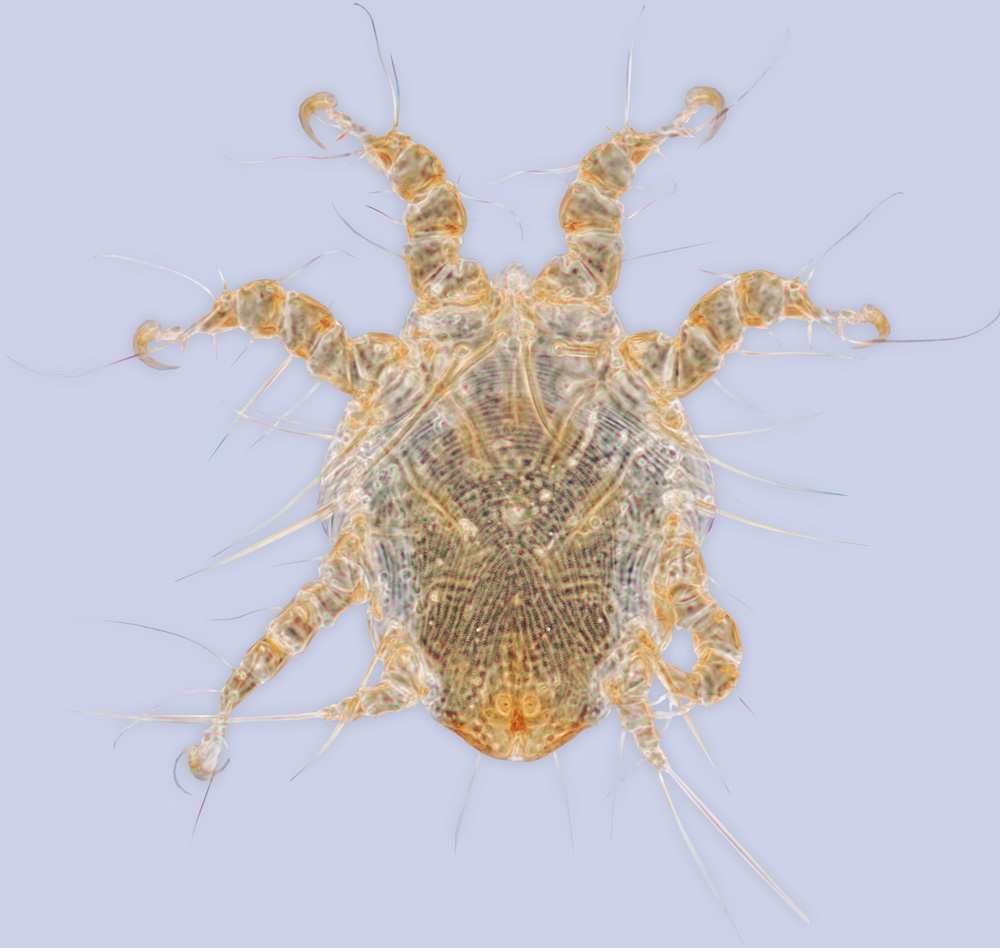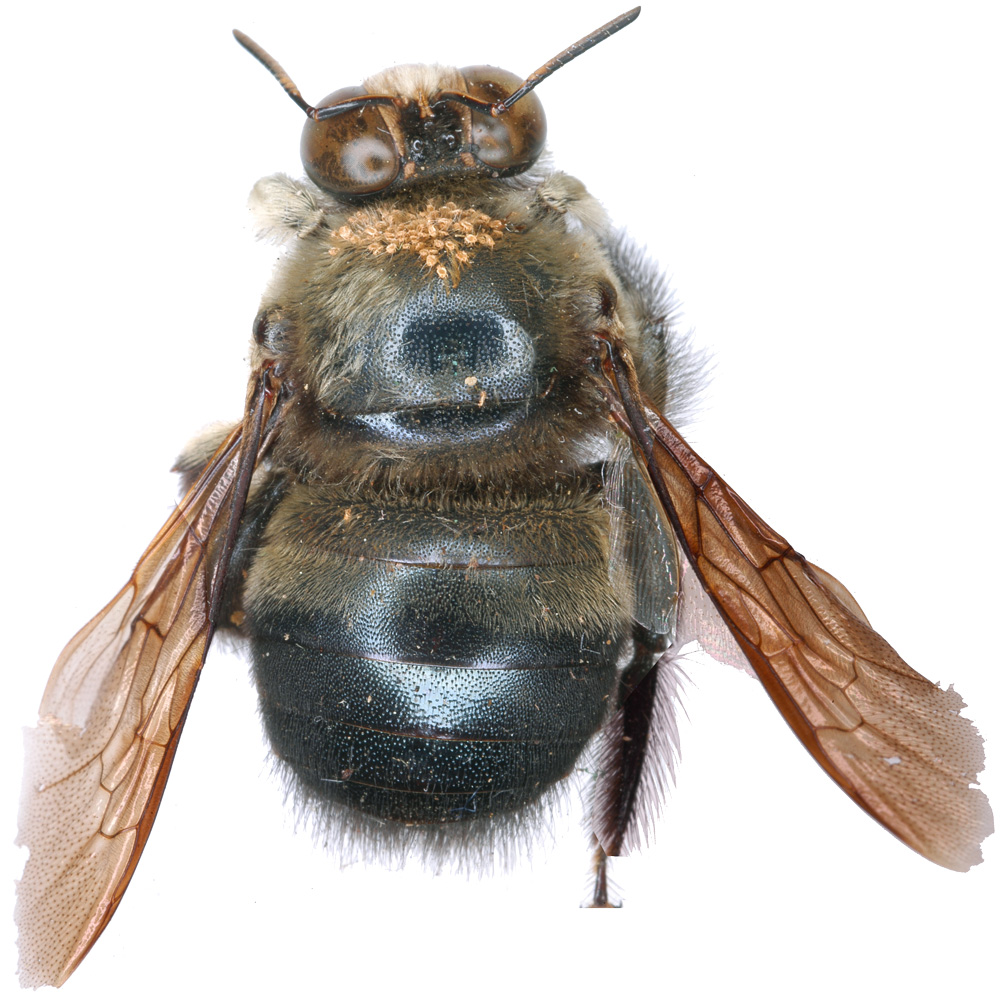Bee Mites : Acari : Acariformes : Sarcoptiformes : Chaetodactylidae : Sennertia : Sennertia species
Sennertia lauta Klimov and OConnor, 2007
Sennertia lauta Klimov & OConnor in Klimov et al., 2007b: 125, Figs 2, 11,12; Klimov & OConnor, 2008: 231
Material (show database records). Holotype: HDN - PHILIPPINES: Davao, Davao (Mindanao Is.), ex f Xylocopa (Zonohirsuta) fuliginata Pérez, 1901 (groove between scutellum and metanotum), no date, Baker, AMNH, BMOC 05-0420-140. Paratypes: 10 HDNs – same data; 8 HDNs - Dapitan, Dapitan (Mindanao Is.), ex f X. fuliginata (groove between scutellum and metanotum), no date, Baker, AMNH BMOC 05-0420-209; 11+11 HDNs – Palawan, Mantalingajan Mt., Pinigisan, 600 m, ex f Xylocopa (Zonohirsuta) dejeanii Lepeletier, 1841 (axillar area + groove between scutellum and metanotum), 6.ix.1961, Noona Dan ?, AMNH, BMOC 05-0420-136; 12 HDNs mounted - Zamboanga, Zamboanga (Mindanao Is.), ex m X. fuliginata (anterior scutum and adjacent pronotum), no date, Baker, AMNH, BMOC 05-0420-210; 11 HDNs - N W Panay, ex f X. fuliginata (groove between scutellum and metanotum), no date, Baker, AMNH, BMOC 05-0420-208; 9 HDNs - MALAYSIA: Sarawak, Kuching, ex m X. dejeanii (propodeum), 17.vi.1910, no collector, AMNH, BMOC 05-0420-139; 2 HDNs - same locality, ex X. sp., no date, no collector, Cornell lot 466, CUIC, BMOC 74-0729-006. Holotype in AMNH, paratypes in AMNH, CUIC, HNHM, OSU, UMMZ.
Description. Deutonymph. Gnathosomal solenidia shorter than 1/3 width of femur I, longer than distance between them. Distance between gnathosomal solenidia distinctly exceeds diameter of alveolus of vF I. Rostral projection without sclerite. Supracoxal setae scx situated on separate small and rounded sclerites. Alveoli of vi anterior to level of se and si; distance between them shorter than distance si-si. Lateral edges of hysterosomal shield in anterior part not narrowing, rounded. Dorsal hysterosomal pouch absent. Distance between anterior margin of hysterosomal shield and setae si substantially exceeds diameter of si alveoli. Striate pattern of idiosomal cuticle outside hysterosomal shield without sclerotization; formed by long striae. Distinct vestiges of vi present. Setae si slightly anterior to se; longer than 1/3 of se; almost as thick as se. Setae c1 and d1-h1 uniform in length, microsetae. Setae c1 microsetae; posterior to anterior margin of hysterosomal shield. Setae c3 distinctly widened. Setae d1 situated on hysterosomal shield. Cupules ia situated closer to alveoli of c2 than to alveoli of cp. Sclerite between ia and d2 absent. Setae e2 subequal with d2, width not exceeding diameter of their alveoli. Alveoli of setae e2 not touching hysterosomal shield. f2 situated lateral to hysterosomal shield. Lateral opisthonotal gland openings situated on hysterosomal shield. Cupules im situated approximately on line connecting d2-e2, closer to e2 than to d2. Setae 4b, g, and 4a widened but without distinct rhomboid widening. At least pR I-II, sR III, wa I-II, wF IV, gT I-II, hT I-II, and kT III filiform or nearly filiform. Coxal setae 1a inflated at basally. Coxal setae 4b widened at base, alveolar sclerites of 4b, if present, not fused to posterior apodemes II. Alveolar sclerites of c3 and 3a present or absent not fused with anterior apodemes III. Posterior apodemes II and anterior apodemes III distinctly fused. Anterior portion of posterior apodeme II distinct, well-sclerotized before its fusion to anterior apodeme III. Anterior apodemes IV arc-like, not interrupted.. Posterior apodeme IV absent. Conoids ps2 posterior to anterior transverse level of central suckers (ad1+ad2). Conoids ps2 anterior to ps1, situated outside outer level of ad1+ad2. Transparent margin of anterior suckers (ad3) without rough sclerotization. Suckers ad3 not enlarged, smaller than central suckers. Posterior and lateral borders of attachment organ evenly sclerotized, forming distinct frame. Rudiment of process for attachment of dilators of anal valves (situated in region of anterior cuticular suckers) mediad to marginal sclerotized border of attachment organ. Lateral margins of attachment organ distinctly separated anteriorly. Alveolar sclerite of ps2 with weakly sclerotized edges, edges not straight. Sclerotized rudiment of anterior cuticular suckers present. Longitudinal hysterosomal sclerite present, long. Ventral hysterosoma smooth. Genual setae mG I-II simple. Genual setae mG I shorter than genu I, mG II distinctly shorter than leg II, but longer than femur II. Tarsal setae la I-II distinctly longer than famulus. Tarsal setae ra I-II not bifid. Tarsal setae ra I-II spiniform. Tarsal setae wa I-II and s III nearly needle-like, slightly widened basally and with attenuated end. Tarsal setae d I-II slightly widened. Tarsal setae d and f I-II almost symmetrical. Alveoli of tarsal setae d and f I not touching. Solenidion ω3 closer to f I than to ω1. Posterio-proximal lobe of ambulacral stalk distinctly elongated, with sides more then 2 times longer than base. Posterior condylophore present. Anterior condylophore I-II bent distally. Setae mG II widened and flattened. Setae vF II widened and flattened. Seta d III situated close to tarsal base, distance to base shorter than diameter of d III alveolus. Leg IV extending to posterior edge of hysterosoma. Tarsus IV not enlarged, about 3 times shorter than width of trochanter IV. Tarsus IV fused to tibia dorsally. Setae w IV thick, almost as thick as 1/2 of d IV width, distinctly longer than leg IV; situated at base of tarsus IV. Setae f IV short. Setae s IV absent. Setae wF IV distinctly extending beyond apex of tarsus IV, longer than leg IV.
Diagnosis. Gnathosomal solenidia longer than distance between them (shorter in all other species of the horrida-group). Setae f2 situated lateral to hysterosomal shield (on hysterosomal shield in S. horrida and S. madagascarensis, variabale in S. potanini). Tarsal setae ra I-II spiniform, massive (filiform in S. madagascarensis , blade-like in S. horrida and S. potanini). Setae vF II widened and flattened (nearly filiform in all other species of the horrida-group). The new species is closely related to Sennertia ratiocinator sp. nov. but differs by the thinner setae 1a and longer setae si, se, cp, and e2 (Table 3). None of the measurements alone can be used for complete discrimination between the two species. The sum of the ratios, width of 1a/width of se and length of idiosoma/length of si is 2.7-3.3 (3.0±0.15, n=54), whereas in S. ratiocinator, it is 3.8-4.9 (4.2±0.25, n=36). A canonical variates analysis based on these four, size-corrected (Darroch and Mosimann 1985), variables resulted in 100% classification accuracy (not reported here).
Etymology. Lautus (neat, elegant, splendid) is a Latin adjective.
Hosts. Xylocopa (Zonohirsuta) fuliginata Pérez, 1901 (type host); Xylocopa (Zonohirsuta) dejeanii Lepeletier, 1841.
Distribution (Show map). Philippines (type locality), Malaysia.
Biology. On host females, the mites attach to the groove between scutellum and metanotum, whereas on males they are situated on the anterior scutum (see Figs below).
References
Klimov, P. B. & B. M. OConnor. 2008. Morphology, evolution, and host associations of bee-associated mites of the family Chaetodactylidae (Acari: Astigmata), with a monographic revision of North American taxa. Miscellaneous Publications Museum of Zoology University of Michigan.199: 1-243.
Klimov, P. B., S. B. Vinson & B. M. OConnor. 2007. Acarinaria in associations of apid bees and chaetodactylid mites. Invertebrate Systematics.21: 109-136.
Image Gallery
B. OConnor and P. Klimov ©
Created: May 26, 2011
Last modified: 



